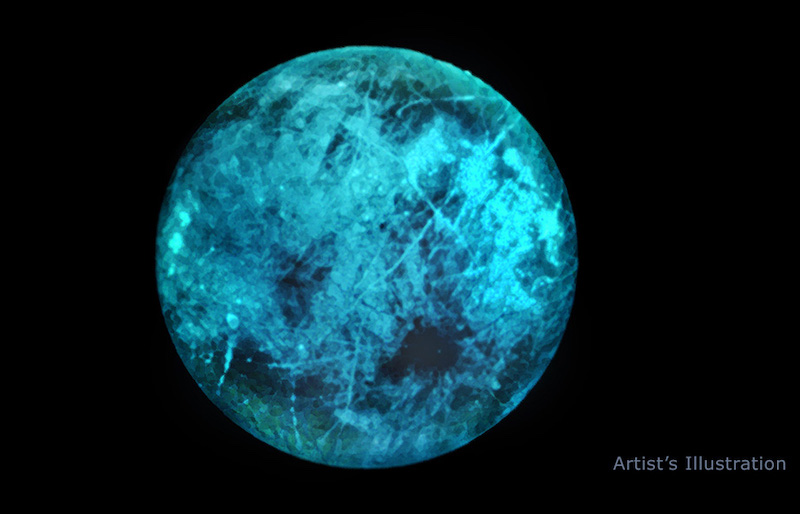
New lab experiments that re-created the environment of Jupiter’s large moon Europa suggest that the icy world shines, even on its nightside.
As icy, ocean-filled Europa – one of Jupiter’s 79 known moons – orbits the planet, Jupiter bombards Europa’s surface night and day with electrons and other particles, bathing it in high-energy radiation. As the electrons penetrate the moon’s surface, they energize the molecules underneath. According to the new study, published November 9, 2020, in the peer-reviewed journal Nature Astronomy, when those molecules relax, they release energy as visible light, making Europa glow in the dark.
EarthSky 2021 lunar calendars now available! They make great gifts. Order now. Going fast!
Variations in the glow and the color of the glow itself could reveal information about the composition of ice on Europa’s surface, say the scientists. That’s because different salty compounds react differently to the radiation and emit their own unique glimmer, so color will vary based on the real composition of Europa’s surface.
The new analysis, from scientists at NASA’s Jet Propulsion Laboratory (JPL) in Southern California, details what the glow would look like, and what it could reveal about the composition of ice on Europa’s surface. According to a NASA statement:
Different salty compounds react differently to the radiation and emit their own unique glimmer. To the unaided eye, this glow would look sometimes slightly green, sometimes slightly blue or white and with varying degrees of brightness, depending on what material it is.
Scientists use a spectrometer to separate the light into wavelengths and connect the distinct “signatures,” or spectra, to different compositions of ice. Most observations using a spectrometer on a moon like Europa are taken using reflected sunlight on the moon’s dayside, but these new results illuminate what Europa would look like in the dark. JPL’s Murthy Gudipati, lead author of the study, said in a statement:
We were able to predict that this nightside ice glow could provide additional information on Europa’s surface composition. How that composition varies could give us clues about whether Europa harbors conditions suitable for life.
That’s because Europa holds a massive, global interior ocean that could percolate to the surface through the moon’s thick crust of ice. Scientists have inferred from prior observations that Europa’s surface could be made of a mix of ice and commonly known salts on Earth, such as magnesium sulfate (Epsom salt) and sodium chloride (table salt). The new research shows that incorporating those salts into water ice under Europa-like conditions and blasting it with radiation produces a glow.
That much was not a surprise, said the researchers, because it’s easy to imagine an irradiated surface glowing. Scientists know the shine is caused by energetic electrons penetrating the surface, energizing the molecules underneath. When those molecules relax, they release energy as visible light. But the study researchers didn’t expect to see variations in the glow itself tied to different ice compositions. JPL’s Bryana Henderson, a study co-author, said:
But we never imagined that we would see what we ended up seeing. When we tried new ice compositions, the glow looked different. And we all just stared at it for a while and then said, ‘This is new, right? This is definitely a different glow?’ So we pointed a spectrometer at it, and each type of ice had a different spectrum.
Does Europa glow in the dark? A new @NASAJPL lab experiment finds that the icy moon shines, even on its nightside. This ice glow could provide insights on Europa's composition, giving us clues about whether the moon harbors conditions suitable for life: https://t.co/UuoSN6lNWz pic.twitter.com/9alExylEGp
— NASA Astrobiology: Exploring Life in the Universe (@NASAAstrobio) November 9, 2020
A moon that’s visible in a dark sky may not seem unusual; we see our own moon because it reflects sunlight. But Europa’s glow is caused by an entirely different mechanism, the scientists said. Imagine a moon that glows continuously, even on its nightside, the side facing away from the sun. Gudipati said:
If Europa weren’t under this radiation, it would look the way our moon looks to us, dark on the shadowed side. But because it’s bombarded by the radiation from Jupiter, it glows in the dark.
Bottom line: A new study suggests Jupiter’s large moon Europa shines, even on its nightside, thanks to a relentless pummeling of radiation from the planet.
Source: Laboratory predictions for the night-side surface ice glow of Europa











